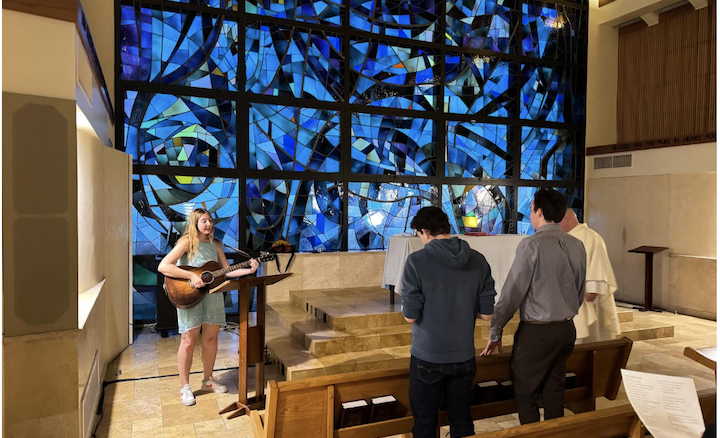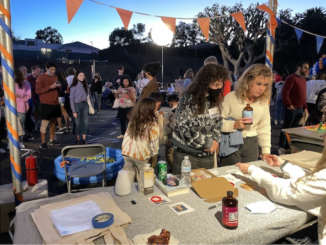
For Roman Catholic students at Pepperdine University, a predominantly Protestant institution, navigating their faith can be both a challenge and a rewarding learning experience.
In the Fall 2024 semester, Roman Catholic students represented 17% of Seaver College compared to Protestant students making up 62%, according to data from the Office of Institutional Effectiveness.
“I think there are a lot of misconceptions about Catholics,” said Noelle Cottingham, senior philosophy major and vice president of communication for the Catholic Student Association. “I’ll have people say, like, are you religious? And I’ll say, well, I’m Catholic. And they’ll be like, ‘Oh, I’m Christian.’ And it’s like, what you mean is you’re Protestant. Yeah. Because we’re all Christians.”
Pepperdine identifies with the Protestant Church of Christ denomination, and mostly gears spiritual life toward Protestant students, with worship nights like The Well and the required Core Chapel for first-years and sophomores. However, there are still resources and opportunities available for Roman Catholic students such as group events with the Catholic Student Association, the local Catholic church, Our Lady of Malibu, and access to Catholic professors and staff.
Differences between Roman Catholic and Protestant communities
Currently there are nearly three times as many Roman Catholic students than Church of Christ, landing at 17% compared to 5%. Most students are nondenominational forms of Protestant Christianity. Also, nearly 12% are undeclared or indicated they have no faith identity, according to OIE data.
Comparing Pepperdine to a national scale, just over 42% of Americans identify as Protestant, 23.5% are Roman Catholic and 25% are unaffiliated with any religion, according to 2023 data from the Public Religion Research Institute.
Protestants broke off from the Catholic communion in the 1500s, and now there are a few hundred varieties worldwide, according to Pew Research.
Both Catholics and Protestants share core Christian beliefs, but also diverge in certain aspects. Catholics follow the authority of the Pope and the Catholic Church’s traditions, while Protestants emphasize individual interpretation of the Bible and a decentralized church structure. Additionally, Catholics practice seven sacraments, whereas Protestants generally recognize only two, according to Brittanica.
Cynea Casidsid, a sophomore psychology and English major who identifies as Roman Catholic, said she has learned the differences between Protestants and Catholics first-hand through conversations with her peers and gatherings on campus, such as The Well.
“It’s just like, hard finding people who really understand Catholic kind of ideas, the makeup even of just the churches, and the way that we come together is pretty different,” Casidsid said.
While The Well is welcoming to all students, Roman Catholic students like Casidsid experience this form of worship a lot differently from Protestants.
“I don’t think I was there for the reason that other people were there, the worship was different,” Casidsid said.
She specifically felt a bit ostracized from the worship music The Well offers.
“I was taught God was like, he’s a big serious scary figure sometimes,” Casidsid said. “But Protestant Christians are like playing the guitar and singing with Jesus, like that kind of image.”
Because Casidsid grew up in a Catholic Filipino community, she didn’t know how to comfortably join in with the worship. It felt awkward for Casidsid because it was out of her routine that she had been accustomed to her whole life.
This change in environment and worship routine led her to become more aware of the differences between Catholicism and Protestantism.
“I think that affects your way of thinking when it comes to certain things,” Casidsid said. “And I start to sense that.”
How Catholic students support each other
Cottingham has navigated her faith journey at Pepperdine through personal reflection and active involvement with the Catholic Student Association, along with many other students on campus.
Raised in Kentucky, where Protestants are prevalent, Cottingham came to Pepperdine expecting a similar dynamic. Around 65% of adults in Kentucky consider themselves Protestant, according to a study by Pew Research.
However, the diverse faith at Pepperdine led her to engage in deeper conversations about religious identity.
Similarly, Micaela Shackleford, a senior psychology and art history major and president of the Catholic Student Association, found a home in the Catholic Student Association to help her navigate campus spiritual life.
“I came to Pepperdine, got connected with the Catholic Student Association here, got connected with Our Lady of Malibu, and just really met some incredible people,” Shackleford said. “And my faith was able to continue to grow.”
As Shackleford and Cottingham are now both board members of the Catholic Student Association, they would recommend Catholic students to get connected. Both work to create a space for Catholics on campus, while also addressing common misconceptions and fostering dialogue between Catholic and Protestant students.
“I think the professors I’ve had have done a pretty good job creating spaces where people can talk about spiritual differences,” Cottingham said.
There are currently 12 student-led ministries on campus, and will soon be 14. The Catholic Student Association is one of the larger groups at Pepperdine, and its mission is to enrich the faith journeys of Catholic students by providing a community of love and support, fostering exploration and growth. Shackleford said. Catholic Student Association also hosts an on-campus Mass once a month, fellowship gatherings about once every other week and service projects.
How the Hub for Spiritual Life is supporting Catholic students
Tim Spivey, vice president of Spiritual Life, said the Church of Christ tradition is part of Pepperdine’s “DNA,” but they are working toward being inclusive of all faith traditions.
“There are spiritual guidelines that the board has said about us remaining connected to that spiritual heritage,” Spivey said. “And at the same time, wanting to do everything that we can to make sure the table is as open as possible to people who come from outside that particular heritage.”
By providing resources, mentorship and a dedicated space for Catholic students, the Hub for Spiritual Life aims to foster a welcoming and inclusive environment for all faith traditions. Spivey said.
“We allow the CSA to have a Mass in the chapel once a month, which, I think it’s worth noting that we had some criticism for, not everybody’ s crazy about that,” Spivey said. “But we feel like that’s a reasonable concession and ask of the Catholic Student Association.”
Additionally, Spivey said he envisions expanding the range of religious organizations on campus to better accommodate the diverse spiritual needs of the student body. He would like to see more dialogue between Roman Catholic and Protestants on campus.
“My hope is that they always feel not only welcome here but embraced here,” Spivey said.
Spivey said Pepperdine as a Church of Christ institution has evolved toward a more open and diversified experience in regard to the campus atmosphere since he was a student in the 90s.
“We’re probably a lot more open now than we ever have been,” Spivey said.
Even within the Church of Christ, the campus atmosphere has become more inclusive.
“When I was a student here, you couldn’t play instrumental music on the campus live, that was forbidden,” Spivey said. “Now you look at things like The Worship Summit and The Well, and it’s just completely different, much more open.”
Misconceptions between Protestants and Catholic faiths lead to animosity
The differences between Protestants and Catholics often lead to aspects of hostility from some non-Roman Catholic students toward different denominations.
“There was one guy who said that I was going to hell [for being Catholic],” Cottingham said.
Cottingham explained he was an outlier from the majority of students, but she has experienced students painting Catholicism in a more negative light compared to Protestantism.
Some misunderstandings from Protestants that Cottingham has noticed include Jesus being a scary figure and Mass being too strict to be enjoyable, which led to unexpected words of hatred for Catholics.
“They’ll [some Christian students] think that Catholics worship Mary or worship the saints,” Shackleford said.
Stephen Weinstock, a senior integrated marketing communication major who identifies as a nondenominational Christian, has regularly discussed religious views with Cottingham. He said he has problems with the Roman Catholic Church itself as an organization but not the individual members.
“There was one time when we were talking about the idea of ‘venerating saints,’ and we both had completely opposite viewpoints,” Weinstock said. “At the end of the day I am not going to make that a barrier to our friendship, when we both are acknowledging Jesus as the ultimate power.”
Shackleford said it is crucial to address these misconceptions and foster open dialogue to promote growth for deeper understanding among different faith traditions.
Shackleford witnessed the diversity of religions and cultures while studying abroad in Switzerland. Ultimately these differences led her to understanding of God’s unity and the unity of humanity.
“God is reconciling all the world to himself,” Shackleford said.
Addison Melone reported this enterprise story in Jour 241 during the Fall 2024 semester under the supervision of Dr. Christina Littlefield and Dr. Theresa de los Santos. Dr. Littlefield supervised the web article.




